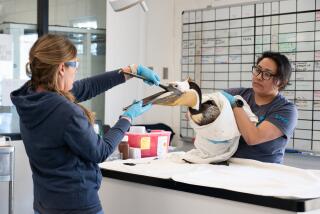Vets Check Heart of Rare Eagle
SAN DIEGO â Wearing a peaceful look brought on by anesthesia, the sleeping patient was spread gently on the operating table for the delicate examination Tuesday.
âIt looks like a leaky mitral valve,â said the radiologist, a condition that, while serious and deserving of follow-up attention, is not considered immediately life-threatening. Even if it worsens, most patients respond favorably to drug therapy.
It was good news for this VIP (Very Important Predator): a female harpy eagle, part of the San Diego Zooâs avian collection since 1991.
Specialists used X-ray and ultrasound equipment to see and listen to her rapidly beating heart. They worked quickly, lest she awake prematurely and become angry.
Once a flourishing population from southern Mexico to the Amazon River, the harpy eagle is now an endangered species because of poaching and habitat destruction.
The San Diego eagle and her mate are the only breeding pair of harpy eagles in any zoo or aviary in North America, zoo officials said. The pair have produced 11 chicks and are thought to have years remaining to reproduce.
Two of the chicks have been released into the wild. The others have been placed with other zoos, in hopes of spreading word about the peril faced by the bird with the majestic black, white and gray feathers.
Although the San Diego Zoo has 2,000 birds from 400 species in its collection -- more than any zoo in the United States -- Dave Rimlinger, curator of birds, acknowledges a special fondness for the harpy eagles.
âI love âem,â Rimlinger said. To him, the solitary birds have a majestic look and a strong presence, similar to that of tigers and other large carnivores.
During an exam for West Nile virus -- a routine precaution -- zookeepers heard a heart murmur in the female harpy. The maleâs heart was fine. So was that of the most recent chick -- soon to be sent to a zoo in Florida.
Blood work showed no sign of infection. Plus the female harpy was her usual self: living atop a tree with her mate (harpy eagles are monogamous) in the zooâs birds of prey aviary.
Still, to be careful, a heart exam was ordered at the zooâs hospital. The harpy was added to those patients to be examined by Seth Wallack, a veterinarian radiologist and zoo consultant. Also on Tuesdayâs patient list: a pygmy marmoset, a Bengal slow loris and a Japanese green pigeon.
Conducting a heart exam on a bird is no easy task. The thick bones that form the breastplate block the ultrasoundâs probe. Wallack had to maneuver for a picture that looked upward from the birdâs liver. He also listened.
âYou want the sound to be smooth, less like the noise made by a washing machine,â he said.
Two zookeepers and a zoo veterinarian held down the 15-pound patient, whose wings stretch to more than 6 feet. A leaky mitral valve means that some blood may be flowing in the wrong direction, a common condition in aging creatures.
âIâm optimistic,â said Karen Kearns, the zooâs associate veterinarian. âThere are a lot worse things we could have found.â
In the wild, harpy eagles are considered one of natureâs most lethal predators. The talons, as large as a grizzly bearâs, can seize a small monkey or a sloth while the eagle uses its beak to deliver death blows.
For the heart procedure, the birdâs feet were wrapped in blue booties and its beak was taped shut, with space only for an oxygen tube to be inserted down its throat. Even veteran zookeepers do not approach the harpy eagles casually in their enclosure.
âYouâre a very good bird,â Wallack said to his sleeping patient, âwhen youâre under anesthesia.â
More to Read
Sign up for Essential California
The most important California stories and recommendations in your inbox every morning.
You may occasionally receive promotional content from the Los Angeles Times.










